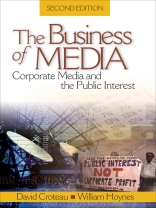The Business of Media presents the critical, yet careful, analysis of the rapidly changing media industry that students need in order to get behind the headlines and understand our increasingly media-saturated society. The writing is clear and jargon-free, accessible to undergraduates without requiring a background in economics.
Key Features:
- Examines the basic dynamics that underlie the changing media industry and the possible influence these changes are having on society (society′s insatiable quest for profits and democratic society′s need for a media system that serves the public interest)
- Draws from both social and economic theory to create two conceptual frameworks: market model, and public sphere model
- Focus on devlopments in the last decade to major media industry trends mapping structural organization, the rise of media conglomerates, and their new strategies
- Assesses the impact of recent changes in the media industry using the public sphere model on social and political life
- Offers clear, concise, jargon-free writing accessible to all students and professionals without an economics background
Innehållsförteckning
Introduction: The New Media Industry and an Old Dilemma
Part I. Profits and the Public Interest: Theoretical and Historical Context
1. Media, Markets, and the Public Sphere
The Market Model
The Public Sphere Model
Why Media Are Different From Other Industries
The Tradition of Civic Responsibility
The Public Interest
Conflicting Logics
2. The Rise and (De)Regulation of the Media Industry
The Changing Business of Media and Regulation: The Case of ABC and Disney
The Growth of Media
The Evolution of Media
Media Policy and the Public Interest
Part II. Industry Structure and Corporate Strategy: Explaining the Rise of Media Conglomerates
3. The New Media Giants: Changing Industry Structure
Making Sense of Mergers
Structural Trends in the Media Industry
Interpreting Structural Changes
4. Strategies of the New Media Giants
The Case of Titanic
Strategies of the New Media Giants
Beyond Market Strategies: The Spector of Monopolies
Conclusion
Part III. Neglecting the Public Interest: Media Conglomerates and the Public Sphere
5. How Business Strategy Shapes Media Content
Considering the Public Interest
Homogenization and Imitation
Trivialization and Sensationalism
Media Constraint I: Commercial Interests
Media Constraint II: Censorship and Conflicts of Interest
Conclusion
6. How the Media Business Influences Society
Social Influences
Political Influence
The Special Role of News Media
Conclusion
7. Choosing the Future: Citizens, Policy, and the Public Interest
Regulatory Policy and the Public Interest
Media and Public Policy
Public Policy and Public Broadcasting
Journalism as a Profession
Citizen Activism and Alternative Media
The Limits of Media, The Importance of Media
Appendix: Select Online Resources for Studying the Media Industry, Media Policy, and Media Education
Notes
Om författaren
William Hoynes is dean of the faculty and professor of sociology at Vassar College in Poughkeepsie, New York. He teaches courses on media, culture, and social theory, and is former director of Vassar’s Media Studies program. He is the author of Public Television for Sale: Media, the Market, and the Public Sphere.












